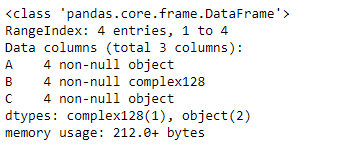Python | Pandas dataframe.infer_objects()
Last Updated :
19 Nov, 2018
Python is a great language for doing data analysis, primarily because of the fantastic ecosystem of data-centric python packages.
Pandas is one of those packages and makes importing and analyzing data much easier.
Pandas
dataframe.infer_objects() function attempts to infer better data type for input object column. This function attempts soft conversion of object-dtyped columns, leaving non-object and unconvertible columns unchanged. The inference rules are the same as during normal Series/DataFrame construction.
Syntax: DataFrame.infer_objects()
Returns : converted : same type as input object
Example #1: Use
infer_objects() function to infer better data type.
Python3
# importing pandas as pd
import pandas as pd
# Creating the dataframe
df = pd.DataFrame({"A":["sofia", 5, 8, 11, 100],
"B":[2, 8, 77, 4, 11],
"C":["amy", 11, 4, 6, 9]})
# Print the dataframe
df

Let's see the dtype (data type) of each column in the dataframe.
Python3 1==
# to print the basic info
df.info()

As we can see in the output, first and third column is of
object type. whereas the second column is of
int64 type. Now slice the dataframe and create a new dataframe from it.
Python3 1==
# slice from the 1st row till end
df_new = df[1:]
# Let's print the new data frame
df_new
# Now let's print the data type of the columns
df_new.info()


As we can see in the output, column "A" and "C" are of object type even though they contain integer value. So, let's try the
infer_objects() function.
Python3 1==
# applying infer_objects() function.
df_new = df_new.infer_objects()
# Print the dtype after applying the function
df_new.info()

Now, if we look at the dtype of each column, we can see that the column "A" and "C" are now of
int64 type.
Example #2: Use
infer_objects() function to infer better data type for the object.
Python3
# importing pandas as pd
import pandas as pd
# Creating the dataframe
df = pd.DataFrame({"A":["sofia", 5, 8, 11, 100],
"B":[2 + 2j, 8, 77, 4, 11],
"C":["amy", 11, 4, 6, 9]})
# Print the dataframe
df

Let's see the dtype (data type) of each column in the dataframe.
Python3 1==
# to print the basic info
df.info()

As we can see in the output, first and third column is of
object type. whereas the second column is of
complex128 type. Now slice the dataframe and create a new dataframe from it.
Python3 1==
# slice from the 1st row till end
df_new = df[1:]
# Let's print the new data frame
df_new
# Now let's print the data type of the columns
df_new.info()


As we can see in the output, column "A" and "C" are of object type even though they contain integer value. Similar is the case with column "B". So, let's try the
infer_objects() function.
Python3 1==
# applying infer_objects() function.
df_new = df_new.infer_objects()
# Print the dtype after applying the function
df_new.info()

Notice, the dtype for column "B" did not change.
infer_objects() function tries to do soft conversion leaving non-object and unconvertible columns unchanged.